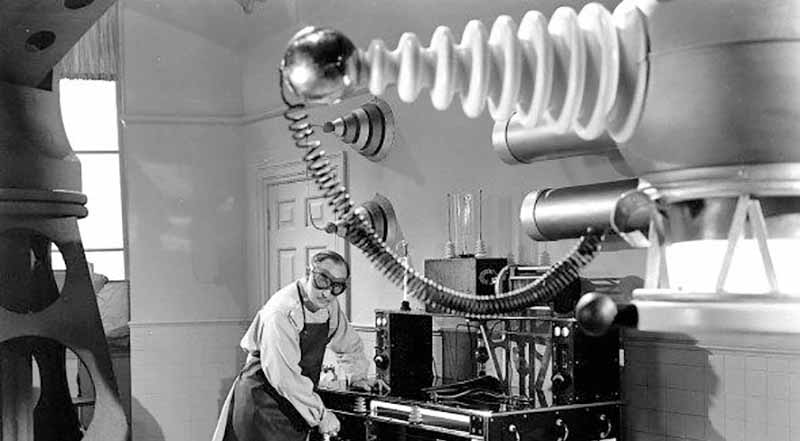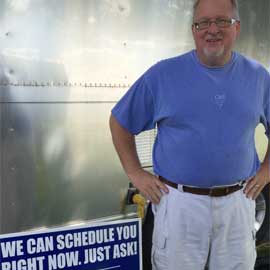
CARING FOR YOUR RV INVESTMENT
HOW DO I FIX MY RV’S TANK SENSORS?
If there’s one question we’ve literally heard tens of thousands (hundreds of thousands?) of times, it’s how to get misreading tank sensors working again. It has to be the number one frustration with RVers, so much so that most simply give up and just accept that they will never read accurately — many thinking that way right from the first days of owning their new RV.
WHAT, EXACTLY, ARE TANK SENSORS?
Most modern RVs have one of two types of sensors in their holding tanks: nub- or protrusion-style or external electronic strips.
Nub- or protrusion-style sensors are either small metallic nubs about the size of a small pea or a longer rod, sometimes covered with a partial hood. They are installed by drilling a small hole in the side of the tank and inserting a metal sensor that extends inside the tank. The protrusion for small nub-style is the most common. The most common protrusion-style sensor is the Horst brand. The feature a curved “hood” over the sensor rod sticking inside the tank, presumably to protect it from accumulating waste or toilet paper on the sensor (though our guess is waste and TP accumulate easily on the hood…and thus, end up covering the sensor rod).
These types of sensors work by measuring an electrical connection between one sensor on one side of the tank (placed near the bottom) and a corresponding sensor on the other side, of which three or four are placed in the tank in a stepped, ascending pattern. The higher the tank sensor triggered on the other side, the more full the tank is, and the corresponding light on the control panel is triggered (1/4, 1/2, 3/4, etc.).
Electronic strip-style sensors are glued to the outside of the holding tank and thus do not have any intrusion into the inside of the tank. These work by sending and measuring an electronic or radio signal pulsed into the tank, reading the capacity. These tend to be much more accurate with a digital percentage reading (e.g. 38% full).
WHY DO THEY FAIL?
Simply put, tank sensors mainly fail because of a buildup of waste inside an RV tank. Yes, failed electronics, broken or unattached connector wires, or failed reading boards can also cause misreads of tank capacities, but it’s almost always because thick, sticky waste has built up in the tank.
In black tanks, this is, predictably, human waste and dissolved or broken down toilet paper. In gray tanks, it’s molds and mildews that have grown in the hot, moist environment and are resisting evacuation when the tank is emptied as their adhesion is quite strong to tank surfaces.
WHAT ABOUT TANK ADDITIVES? DO THEY HELP?
Honestly, no. In fact, they do more to make a bad situation worse. Your RV’s tanks are part of a holding system; waste is held in them until they are full (indicated by the tank sensors) and then they are emptied. By adding tank additives that break down, dissolve, or liquify tank contents, you are converting your holding tank into a septic tank.
Why is that bad? Now, instead of a tank full of (mostly) water with solids suspended in it, you have a tank full of (at best) thick oatmeal-like solution or (at worst) a tank full of peanut butter sludge, thickening up by each passing hour the tank solution is at work.
BUT EVERYONE RECOMMENDS TANK SOLUTIONS
Yes, they do, and “they” should stop. The enzymes and chemicals in typical, commercially-available tank solutions are breaking down what’s inside the tank, concentrating it into a thick, sticky mixture. That sludge is covering tank surfaces (where either the intruding tank sensors are or the pulse from external sensors is trying to penetrate). It’s also thickening up at the bottom of the tank and in corners (where, coincidentally, the sensors are locating). The thicker the sludge gets with each use, the more impossible it is to get it out.
WHAT ABOUT TANK RINSERS?
Almost every modern RV has some sort of tank rinsing system in their black tanks. Some high-end Class As and fifth wheels also have them in their gray tanks.
These rinsing systems spray a small stream of water at roughly 100 to 150 PSI (pounds per square inch, a measurement of pressure or intensity). These tend to spray in a set pattern (some spray systems have a rotating head for wider dispersal).
It is recommended that you turn on and use this spray system when emptying your tanks. The added water jet and agitation can help to rinse the inside of the tanks.
These spray systems, however, are of little use in removing built up or caked-on waste from continued and regular use of tank additives that break down, dissolve, or liquify tank contents. The waste is just too thick and sticky to be affected by the water spray.
OK, WHAT IF I USE THE KLEEN TANK TANK SOLUTION?
Kleen Tank’s tank solution is a mixture of water (always good!), Calgon Bath Pearls (a surfactant that breaks the surface tension of water and creates a slippery environment in the tanks), and Pine-Sol (a great odor fighter and it can counter mold and mildew buildup in tanks).
Stopping the use of tank additives that break down, dissolve, or liquify tank contents is a great first step. Using the Kleen Tank tank solution is helpful as well. But you will get the greatest benefit from our tank solution if you FIRST have your tanks professional cleaned. Getting out that peanut butter-like sludge will give you surfaces that are the cleanest, allowing our tank solution to perform best.
Simply using Kleen Tank’s tank solution without first getting your tanks professionally cleaned will do little — if anything — to get tank sensors working.
HOW DOES YOUR TANK CLEANING FIX MISREADING SENSORS?
Assuming the cause of the misreading is not electrical or mechanical error (broken wires, failed electronics, etc.), a professional hydrogen cleaning of your RV’s holding tanks is the first step in getting tanks sensors reading properly again.
Our service uses high water pressure (1500 PSI or about ten times the pressure of your RV’s onboard tank rinsing system) to literally scrub every inside surface of your tanks as clean as they were when they came from the factory. No part of the inside of the tank remains caked in waste, molds, or mildews.
We have many customers who do their own “intense” cleaning (using the rinsing system and repeated flushing) of their tanks before we perform a service on their RV. They are shocked at what we can get to come out of their “clean” tanks.
Only Kleen Tank’s proprietary cleaning processes can get tanks so clean that tank sensors begin working in 95% of the cases. And with those “factory kleen” tanks, customers who then begin using the Kleen Tank tank solution find their tank sensors continue to read accurately.
IN CONCLUSION
Most RVers cause their misreading tank sensor situation through the use of tank additives that break down, dissolve, or liquify tank contents. Stopping the use of these, having your tanks professionally cleaned, and then starting the use of Kleen Tank’s tank solution (with plenty of water use) will almost always resolve misreading sensors.
Contact us to learn more or have a professional tank cleaning services scheduled. With nearly 50 dealers nationwide in the U.S. and Canada (with more added every month), Kleen Tank is the largest, fastest-growing professional tank cleaning company.

Jim Tome, Owner
Hi, I'm Jim Tome and, along with my wife, Debbie, the owners of Kleen Tank LLC, the national leader in RV holding tank cleaning service. We've been RVers like you since 2004 and have traveled all over the U.S. in our Airstream travel trailer. We started the business about twelve years ago and have cleaned tens of thousands holding tanks in thousands of RVs. From tiny weekend travel trailers to monstrous fifth wheels to luxurious motorhomes, I've seen just about every situation there is with RV holding tanks and waste systems. I hope you enjoy our articles; I try to post at least one per week and we've got a great library of them to cover just about every problem. Enjoy!
2 Comments
Keep in mind that we may receive commissions when you click our links and make purchases. However, this does not impact our reviews and comparisons. We try our best to keep things fair and balanced, in order to help you make the best choice for you.
MAKE A QUICK INQUIRY
WE'LL GET RIGHT BACK TO YOU
WE'RE HERE FOR YOU
CONNECT WITH US
844-KLEENME (844-553-3663)
info@KleenTank.com
Facebook.com/KleenTank
Instagram.com/KleenTank
WHAT DOES OUR SERVICE DO?
IT'S PRETTY SIMPLE...
Fixes and corrects your RV's tank sensors almost every time.
Features innovative, hydrojetting technology.
Is a 100% mobile service. We come to you at your site.
Is environmentally safe and makes no mess at your site.
Is chemical-free and all-natural.

Watched the Enjoy the Journey UTube video. Interested in your services.
Great! We always try to educate RVers first, then perform our service. Give us a call at 844-KLEENME (844-553-3663) and we can match you up with one of our Kleen Tank Authorized Dealers.